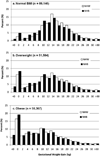Maternal pre-pregnancy weight and gestational weight gain and their association with birthweight with a focus on racial differences
- PMID: 22322428
- PMCID: PMC3677820
- DOI: 10.1007/s10995-012-0950-x
Maternal pre-pregnancy weight and gestational weight gain and their association with birthweight with a focus on racial differences
Abstract
Our objectives were to examine the interaction between maternal pre-pregnancy body mass index (BMI) and gestational weight gain (GWG) and their association with birthweight, with a focus on racial differences. We used birth certificate data from live singleton births of South Carolina resident mothers, who self-reported their race as non-Hispanic white (NHW, n = 140, 128) or non-Hispanic black (NHB, n = 82,492) and who delivered at 34-44 weeks of gestation between 2004 and 2008 to conduct a cross-sectional study. Linear regression was used to examine the relationship between our exposures (i.e., race, BMI and GWG) and our outcome birthweight. Based on 2009 Institute of Medicine guidelines, the prevalence of adequate, inadequate and excessive GWG was 27.1, 24.2 and 48.7%, respectively, in NHW women and 24.2, 34.8 and 41.0%, respectively, in NHB women. Adjusting for infant sex, gestational age, maternal age, tobacco use, education, prenatal care, and Medicaid, the difference in birthweight between excessive and adequate GWG at a maternal BMI of 30 kg/m(2) was 118 g (95% CI: 109, 127) in NHW women and 101 g (95% CI: 91, 111) in NHB women. Moreover, excessive versus adequate GWG conveyed similar protection from having a small for gestational age infant in NHW [OR = 0.64 (95% CI 0.61, 0.67)] and NHB women [OR = 0.68 (95% CI: 0.65, 0.72)]. In conclusion, we report a strong association between excessive GWG and higher infant birthweight across maternal BMI classes in NHW and NHB women. Given the high prevalence of excessive GWG even a small increase in birthweight may have considerable implications at the population level.
Conflict of interest statement
Figures




Similar articles
-
Racial differences in gestational weight gain and pregnancy-related hypertension.Ann Epidemiol. 2014 Jun;24(6):441-7. doi: 10.1016/j.annepidem.2014.02.009. Epub 2014 Mar 3. Ann Epidemiol. 2014. PMID: 24685832 Free PMC article.
-
Impact of maternal diabetes on birthweight is greater in non-Hispanic blacks than in non-Hispanic whites.Diabetologia. 2012 Apr;55(4):971-80. doi: 10.1007/s00125-011-2430-z. Epub 2012 Jan 12. Diabetologia. 2012. PMID: 22237686 Free PMC article.
-
Quantifying the impact of gestational diabetes mellitus, maternal weight and race on birthweight via quantile regression.PLoS One. 2013 Jun 10;8(6):e65017. doi: 10.1371/journal.pone.0065017. Print 2013. PLoS One. 2013. PMID: 23762279 Free PMC article.
-
The Impact of Maternal Diabetes, Obesity and Race on Infant Birth Weights in South Dakota.S D Med. 2017 Feb;70(2):61-66. S D Med. 2017. PMID: 28810088
-
Racial-ethnic differences in pregnancy-related weight.Adv Nutr. 2012 Jan;3(1):83-94. doi: 10.3945/an.111.000984. Epub 2012 Jan 5. Adv Nutr. 2012. PMID: 22332106 Free PMC article. Review.
Cited by
-
Comparison of two proxies for the preconception weight using data from a pre-pregnancy cohort in Benin: Weight measured in the first trimester of pregnancy vs estimated by Thomas' formula.PLoS One. 2024 Nov 4;19(11):e0312840. doi: 10.1371/journal.pone.0312840. eCollection 2024. PLoS One. 2024. PMID: 39495747 Free PMC article.
-
Effect of a CGMS and SMBG on Maternal and Neonatal Outcomes in Gestational Diabetes Mellitus: a Randomized Controlled Trial.Sci Rep. 2016 Jan 27;6:19920. doi: 10.1038/srep19920. Sci Rep. 2016. PMID: 26814139 Free PMC article. Clinical Trial.
-
Association of gestational weight gain with pregnancy complications and delivery outcomes in twins: a study in Northern China.BMC Pregnancy Childbirth. 2025 Aug 18;25(1):861. doi: 10.1186/s12884-025-07790-y. BMC Pregnancy Childbirth. 2025. PMID: 40826023 Free PMC article.
-
Increasing maternal body mass index is associated with systemic inflammation in the mother and the activation of distinct placental inflammatory pathways.Biol Reprod. 2014 Jun;90(6):129. doi: 10.1095/biolreprod.113.116186. Epub 2014 Apr 23. Biol Reprod. 2014. PMID: 24759787 Free PMC article.
-
Physical activity during pregnancy and infant's birth weight: results from the 3D Birth Cohort.BMJ Open Sport Exerc Med. 2017 Jun 19;3(1):e000242. doi: 10.1136/bmjsem-2017-000242. eCollection 2017. BMJ Open Sport Exerc Med. 2017. PMID: 28761717 Free PMC article.
References
-
- Flegal KM, Carroll MD, Ogden CL, Curtin LR. Prevalence and trends in obesity among US adults: 1999–2008. JAMA. 2010;303:235–241. - PubMed
-
- Institute of Medicine and National Research Council 2009. Weight gain during pregnancy: reexamining the guidelines. Washington, DC: The national Academies Press; 2011. - PubMed
-
- Siega-Riz AM, Viswanathan M, Moos MK, Deierlein A, Mumford S, Knaack J, Thieda P, Lux LJ, Lohr KN. A systematic review of outcomes of maternal weight gain according to the Institute of Medicine recommendations: birthweight, fetal growth, and postpartum weight retention. Am.J.Obstet.Gynecol. 2009;201:339–314. - PubMed
-
- Alexander GR, Tompkins ME, Allen MC, Hulsey TC. Trends and racial differences in birth weight and related survival. Matern.Child Health J. 1999;3:71–79. - PubMed
-
- Alexander GR, Wingate MS, Bader D, Kogan MD. The increasing racial disparity in infant mortality rates: composition and contributors to recent US trends. Am.J Obstet.Gynecol. 2007 - PubMed
Publication types
MeSH terms
Grants and funding
LinkOut - more resources
Full Text Sources
Medical

